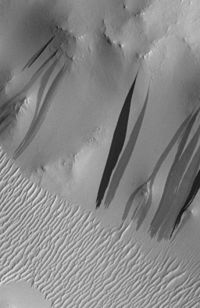

Dark slope streaks are narrow, avalanche-like features common on dust-covered slopes in the equatorial regions of Mars.[2] They form in relatively steep terrain, such as along escarpments and crater walls.[3] [4] Although first recognized in Viking Orbiter images from the late 1970s,[5][6] dark slope streaks were not studied in detail until higher-resolution images from the Mars Global Surveyor (MGS) and Mars Reconnaissance Orbiter (MRO) spacecraft became available in the late 1990s and 2000s.[1][7]
The physical process that produces dark slope streaks is still uncertain. They are most likely caused by the mass movement of loose, fine-grained material on oversteepened slopes (i.e., dust avalanches).[1][8][9] The avalanching disturbs and removes a bright surface layer of dust to expose a darker substrate.[10] The role that water and other volatiles plays, if any, in streak formation is still debated.[11] Slope streaks are particularly intriguing because they are one of the few geological phenomena that can be observed occurring on Mars in the present day.[12][13][14] [15][16]
- ^ a b c Sullivan, R. et al. (2001). Mass Movement Slope Streaks Imaged by the Mars Orbiter Camera. J. Geophys. Res., 106(E10), 23,607–23,633.
- ^ Chuang, F.C.; Beyer, R.A.; Bridges, N.T. (2010). Modification of Martian Slope Streaks by Eolian Processes. Icarus, 205 154–164.
- ^ https://www.uahirise.org/ESP_040386_1915
- ^ Schorghofer, N.; Aharonson, O.; Khatiwala, S. (2002). Slope Streaks on Mars: Correlations with Surface Properties and the Potential Role of Water. Geophys. Res. Lett., 29(23), 2126, doi:10.1029/2002GL015889.
- ^ Morris, E.C. (1982). Aureole Deposits of the Martian Volcano Olympus Mons. J. Geophys. Res., 87(B2), 1164–1178.
- ^ Ferguson, H.M.; Lucchitta, B.K. (1984). Dark Streaks on Talus Slopes, Mars in Reports of the Planetary Geology Program 1983, NASA Tech. Memo., TM-86246, pp. 188–190. https://ntrs.nasa.gov/archive/nasa/casi.ntrs.nasa.gov/19840015363_1984015363.pdf.
- ^ Chuang, F.C. et al. (2007). HiRISE Observations of Slope Streaks on Mars. Geophys. Res. Lett., 34 L20204, doi:10.1029/2007GL031111.
- ^ Sullivan, R.; Daubar, I.; Fenton, L.; Malin, M.; Veverka, J. (1999). Mass-Movement Considerations for Dark Slope Streaks Imaged by the Mars Orbiter Camera. 30th Lunar and Planetary Science Conference, Abstract #1809. http://www.lpi.usra.edu/meetings/LPSC99/pdf/1809.pdf.
- ^ Barlow, 2008, p. 141.
- ^ "Read, Publish, Review". AGU. Retrieved 2022-09-30.
- ^ Webster, Guy; Brown, Dwayne (December 10, 2013). "NASA Mars Spacecraft Reveals a More Dynamic Red Planet". NASA. Retrieved December 10, 2013.
- ^ Kreslavsky, M.A.; Head, J.W. (2009). Slope Streaks on Mars: A New "Wet" Mechanism. Icarus, 201 517–527.
- ^ Aharonson, O.; Schorghofer, N.; Gerstell, M.F. (2003). Slope Streak Formation and Dust Deposition Rates on Mars. J. Geophys. Res., 108(E12), 5138, doi:10.1029/2003JE002123.
- ^ Dundas, C. 2018. HIRISE OBSERVATIONS OF NEW MARTIAN SLOPE STREAKS. 49th Lunar and Planetary Science Conference 2018 (LPI Contrib. No. 2083). 2026.pdf
- ^ Junior, C. and T. Statella. 2023. Monitoring martian slope streaks in the northeast of Lysus sulci. Icarus. 406: 115737.
- ^ Bhardwaj, A., et al. 2018. Are Slope Streaks Indicative of Global-Scale Aqueous Processes on Contemporary Mars? Reviews of Geophysics: Volume 57, Issue 1 p. 48-77